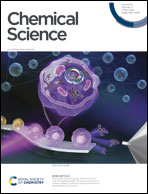Hydrogen bonding bolstered head-to-tail ligation of functional chromophores in a 0D SbF3·glycine adduct for a short-wave ultraviolet nonlinear optical material†
Abstract
The key properties of nonlinear optical (NLO) materials highly rely on the quality of functional chromophores (FCs) and their optimized interarrangement in the lattice. Despite the screening of various FCs, significant challenges persist in optimizing their arrangement within specific structures. Generally, FC alignment is achieved by designing negatively charged 2D layers or 3D frameworks, further regulated by templating cations. In this study, a novel 0D adduct NLO material, SbF3·glycine, is reported. Neutrally charged 0D [SbF3C2H5NO2] FCs, comprising [SbF3] pyramids and zwitterionic glycine, are well-aligned in the structure. The alignment is facilitated by the hydrogen bonding, reinforcing a ‘head-to-tail’ ligation of [SbF3C2H5NO2] FCs. Consequently, the title compound exhibits favorable NLO properties, including a large second-harmonic generation efficiency (3.6 × KDP) and suitable birefringence (cal. 0.057 @ 1064 nm). Additionally, its short absorption cut-off edge (231 nm) positions it as a promising short-wave ultraviolet NLO material. Importantly, the binary SbF3–amino acid system is expected to serve as a new resource for exploring ultraviolet NLO crystals, owing to the abundance of the amino acid family.

- This article is part of the themed collection: Most popular 2024 materials chemistry articles


 Please wait while we load your content...
Please wait while we load your content...